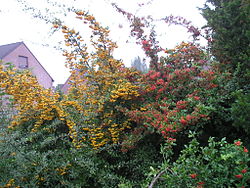Pyracantha coccinea
Appearance
(Redirected from Pyrocantha coccinea)
| Pyracantha coccinea | |
|---|---|

| |
| Scientific classification | |
| Kingdom: | Plantae |
| Clade: | Tracheophytes |
| Clade: | Angiosperms |
| Clade: | Eudicots |
| Clade: | Rosids |
| Order: | Rosales |
| Family: | Rosaceae |
| Genus: | Pyracantha |
| Species: | P. coccinea
|
| Binomial name | |
| Pyracantha coccinea | |
| Synonyms[1] | |
|
Synonymy
| |
Pyracantha coccinea, the scarlet firethorn[2] is the European species of firethorn or red firethorn that has been cultivated in gardens since the late 16th century.[3] The tree has small white flowers. It produces small, bright red berries. Its leaves are slightly toothed and grow opposite to one another. The fruit is bitter and astringent, making it inedible when raw. The fruit can be cooked to make jellies, jams, sauces and marmalade. It ranges from southern Europe to western Asia. It has been introduced to North America and cultivated there as an ornamental plant since the 18th century.
In England, since the late 18th century, it has been used to cover unsightly walls.[4]
Cultivars
[edit]
- Pyracantha coccinea 'Kasan'.[5]
- Pyracantha coccinea 'Lalandei'. About 1874, M. Lalande, a nurseryman in Angers, France, selected from seedlings of P. coccinea an improved form, more freely berrying than the type. A sport has produced a yellow-berried form. These, and further selections, have largely ousted the ordinary form from nursery stock.[6]
- Pyracantha coccinea 'Sparkler'.[7]
References and external links
[edit]- ^ "Pyracantha coccinea M.Roem". Plants of the World Online. Royal Botanic Gardens, Kew. Retrieved 19 May 2025.
- ^ NRCS. "Pyracantha coccinea". PLANTS Database. United States Department of Agriculture (USDA). Retrieved 16 October 2015.
- ^ Alice M. Coats, Garden Shrubs and Their Histories (1964) 1992, s.v. "Pyracantha" notes that it does not appear in John Gerard's Herball of 1597 but was in gardens before 1629, when John Parkinson mentions it, as the "ever greene Hawthorne or prickly Corall tree".
- ^ Coats (1964) 1992.
- ^ P. coccinea 'Kasan' at www.rhs.org.uk. Retrieved 30 Aug 2017.
- ^ Coats (1964) 1992.
- ^ P. coccinea 'Sparkler' at www.rhs.org.uk. Retrieved 30 Aug 2017.
